| Author: | Jan Morrill | ISBN: | 9781610755184 |
| Publisher: | The University of Arkansas Press | Publication: | February 10, 2013 |
| Imprint: | The University of Arkansas Press | Language: | English |
| Author: | Jan Morrill |
| ISBN: | 9781610755184 |
| Publisher: | The University of Arkansas Press |
| Publication: | February 10, 2013 |
| Imprint: | The University of Arkansas Press |
| Language: | English |
In 1941, racial tensions are rising in the California community where nine-year-old Sachiko Kimura and her seventeen-year-old brother, Nobu, live. Japan has attacked Pearl Harbor, people are angry, and one night, Sachiko and Nobu witness three teenage boys taunting and beating their father in the park. Sachiko especially remembers Terrence Harris, the boy with dark skin and hazel eyes, and Nobu cannot believe the boys capable of such violence toward his father are actually his friends. What Sachiko and Nobu do not know is that Terrence’s family had received a telegram that morning with news that Terrence’s father was killed at Pearl Harbor. Desperate to escape his pain, Terrence rushes from his home and runs into two high-school friends who convince him to find a Japanese man and get revenge. They do not know the man they attacked is Sachiko and Nobu’s father. In the months that follow, Terrence is convicted of his crime and Sachiko and Nobu are sent to an internment camp in Arkansas, a fictionalized version of the two camps that actually existed in Arkansas during the war. While behind bars and barbed wire, each of the three young people will go through dramatic changes. One will learn acceptance. One will remain imprisoned by resentment, and one will seek a path to forgiveness.
In 1941, racial tensions are rising in the California community where nine-year-old Sachiko Kimura and her seventeen-year-old brother, Nobu, live. Japan has attacked Pearl Harbor, people are angry, and one night, Sachiko and Nobu witness three teenage boys taunting and beating their father in the park. Sachiko especially remembers Terrence Harris, the boy with dark skin and hazel eyes, and Nobu cannot believe the boys capable of such violence toward his father are actually his friends. What Sachiko and Nobu do not know is that Terrence’s family had received a telegram that morning with news that Terrence’s father was killed at Pearl Harbor. Desperate to escape his pain, Terrence rushes from his home and runs into two high-school friends who convince him to find a Japanese man and get revenge. They do not know the man they attacked is Sachiko and Nobu’s father. In the months that follow, Terrence is convicted of his crime and Sachiko and Nobu are sent to an internment camp in Arkansas, a fictionalized version of the two camps that actually existed in Arkansas during the war. While behind bars and barbed wire, each of the three young people will go through dramatic changes. One will learn acceptance. One will remain imprisoned by resentment, and one will seek a path to forgiveness.















